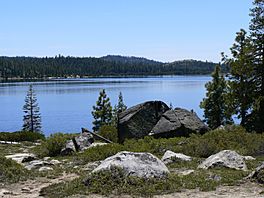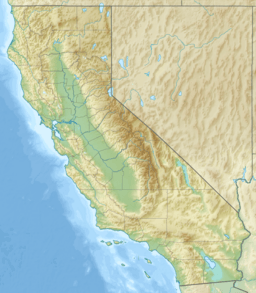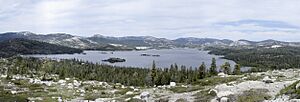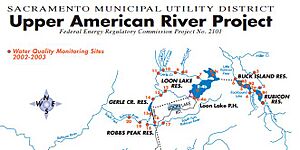Loon Lake (California) facts for kids
Quick facts for kids Loon Lake |
|
|---|---|
 |
|
| Location | Eldorado National Forest El Dorado County, California |
| Coordinates | 38°59′17″N 120°19′52″W / 38.988°N 120.331°W |
| Type | Reservoir |
| Primary inflows | Buck-Loon Tunnel |
| Primary outflows | Gerle Creek |
| Catchment area | 5,200 acres (2,100 ha) |
| Basin countries | United States |
| Max. length | 3.5 mi (5.6 km) |
| Surface area | 1,100 acres (450 ha) |
| Water volume | 76,200 acre⋅ft (94,000,000 m3) |
| Surface elevation | 6,410 ft (1,950 m) |
Loon Lake is a large reservoir located in the beautiful Eldorado National Forest in El Dorado County, California. A reservoir is like a big, artificial lake that stores water. This lake holds about 76,200 acre-feet of water.
Loon Lake was created by the Loon Lake Dam, which was finished in 1963. This dam is part of a bigger project called the Upper American River Project. Its main job is to save water from melting snow in spring. This stored water is then used later in the year to make hydroelectric power.
Most of the water in Loon Lake actually comes from another reservoir called Buck Island Reservoir. It travels through a tunnel called the Buck-Loon Tunnel. Near the lake, you'll find the Loon Lake Chalet, which is a popular spot for winter fun. In summer, people enjoy boating, camping, and other water sports here.
Contents
History of Loon Lake
Loon Lake has an interesting past, changing from a natural lake to a key part of California's water and power system.
Building the First Dam
The first Loon Lake Dam was built way back in 1884. Its purpose was to supply water to the Georgetown Ridge area. This water was mainly used for mining and for irrigation (watering crops). The Georgetown Divide Water Co. owned and ran this early dam.
From Mining to Power
Over time, people realized Loon Lake could be used for more than just mining. In the 1940s, there was a plan to use the lake for making electricity. Later, the Sacramento Municipal Utility District (SMUD) became interested in using Loon Lake for their big power project. In 1961, SMUD took over the rights to the lake. They then built the larger, modern dam you see today.
Making Electricity: The Upper American River Project
The Upper American River Hydroelectric Project (UARP) is a huge system built by SMUD. It was constructed between 1959 and 1985. This project uses water from mountains and canyons to generate electricity. It includes eight powerhouses and 11 reservoirs, with Loon Lake being one of the most important.
How Loon Lake Helps Make Power
Loon Lake Reservoir is a key part of the UARP. It has a 1.6-mile-long tunnel that brings water from Buck Island Lake. The Loon Lake Dam itself is made up of the main dam, a spillway (to release extra water), and an auxiliary dam.
Deep below Loon Lake Reservoir, there's an underground power generator called the Loon Lake Powerhouse. This powerhouse is more than 1,000 feet underground! It has a tunnel that carries water to Gerle Creek Reservoir after it's been used to make power. The electricity generated here travels through power lines to homes and businesses.
How the System Works
SMUD uses the UARP to create electricity and keep the power system running smoothly. Loon Lake, along with Ice House and Union Valley Reservoirs, stores about 90% of the water for the UARP. This water is collected during the winter and spring when snow melts.
In the summer, when people use a lot more electricity, these reservoirs release their stored water. This water flows through the powerhouses to generate power. The water level in Loon Lake usually goes up in spring and reaches its highest point in summer. Then, as water is used for power, the level gradually drops, ready to be refilled by winter snows. This cycle causes the lake's water level to change by about 36 feet each year.
Loon Lake Main Dam
The Loon Lake Main Dam is a strong structure made of rock. It is about 0.4 miles long and 108 feet high. It also has a 250-foot-long spillway to safely release excess water. Another important part is a 910-foot-long auxiliary dam. The current dams were built starting in 1962, replacing an older dam that was there before 1910.
Water Quality
SMUD regularly checks the water quality of Loon Lake. They take samples four times a year: after the first major rain, during spring snowmelt, in summer when water levels are low, and during fall turnover.
Tests show that Loon Lake Reservoir has cold, clear, and well-oxygenated water. Surface temperatures usually range from 13° to 15°C, and even the coldest parts are around 8°C. The water is very clear, with transparency up to 36 feet deep. This means the lake is very healthy!
Plants and Wetlands
The areas around Loon Lake and other UARP reservoirs have mostly "upland" plants, meaning they grow on higher, well-drained ground. You'll find mixed conifer and fir trees, Huckleberry Oak, and Lodgepole Pines. There are also rocky areas along the shore.
Wetlands are areas where the ground is wet for part or all of the year. Around Loon Lake, there are two main types of wetlands:
- Lakeshore-basin meadows: These are found along the shorelines that are flooded seasonally or constantly.
- Depressional meadows: These are wet areas found in dips or hollows in the land.
The largest wetland area at Loon Lake is at the north end. It gets a lot of snowmelt, which helps create these wet conditions. In total, Loon Lake Reservoir has about 38 acres of wetland areas.
Fun Things to Do at Loon Lake
Loon Lake is a great place for outdoor adventures!
- Camping
The Loon Lake Campground is located on Ice House Road, about 23 miles east of Placerville. It sits at an elevation of about 6,500 feet. The campground is usually open from mid-July to mid-October. You can stay for up to 14 nights. There are 53 campsites, and you can make reservations online.
- Rubicon Trail
The Rubicon Trail is a famous 22-mile route for 4-wheel drive vehicles. Part of this exciting off-highway trail is available near the Loon Lake Main Dam.
- Fishing
The Department of Fish and Game regularly releases rainbow trout into the lake, so it's a great spot for fishing! In winter, from January to early March, you can often go ice fishing.
- Boating
There's a boat ramp near the campground, making it easy to launch your boat for water sports. There's also an informal spot to put in boats along the northwest shore.
- Hiking
A popular hiking trail goes from the Loon Lake Campground to the Pleasant Campground, which you can reach by boat. Beyond that, you can access the beautiful Desolation Wilderness area.
- Winter Recreation
SMUD keeps the road leading to the Loon Lake Chalet and its parking lot clear of snow. This makes it a popular destination for winter activities like snowshoeing and cross-country skiing.
Images for kids






